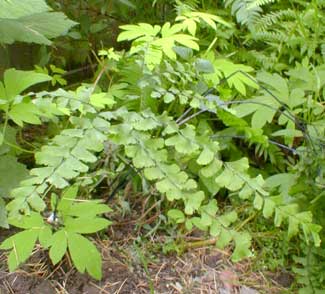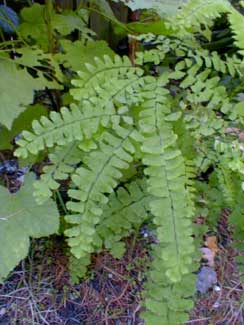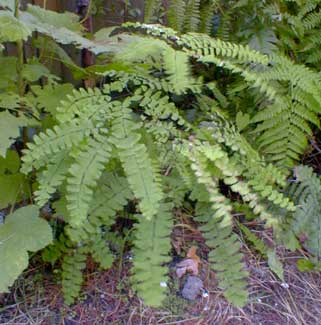
Five-Fingered, Northern,
or American Maidenhair Fern
"And there -- & there --
I watched the maiden-hair."
-Clinton Scollard
(1860-1932)
(1860-1932)
Adiantum pedatum five-fingered maidenhair fern is native to the whole Atlantic seaboard of North America, to the center of the continent, but not the western half of the continent, where its environmental niche is filled by A. aleuticum, the Western Maidenhair. Formerly these two ferns were thought to be variants of the same speces, so outdated references are apt to state that A. pedatum is found throughout the continent.
 It grows in USDA zones 3 through 8, not found in hotter regions. It spreads by underground rhizomes that over a great length of time can become a continuous groundcover. It can be divided autumn or late winter to keep it a clumping fern with only a two foot width or less.
It grows in USDA zones 3 through 8, not found in hotter regions. It spreads by underground rhizomes that over a great length of time can become a continuous groundcover. It can be divided autumn or late winter to keep it a clumping fern with only a two foot width or less.It is not at all sun tolerant, requirng shade to deep shade. Nor can it tolerate droughtiness. Given its minimal requirements of shade & moisture & organically rich soil, it is fantastically hardy. It likes to be surrounded by leaflitter, so does best under deciduous trees. It dies back entirely in winter so is not worried that its location gets sunny after leaf-fall.
The slender one to two-foot fronds are typically arranged in fives or sevens, hence the secondary common name "Five-fingered fern." An established clump has so many overlapping palmate fronds that the feature of fives is not usually obvious.
 It is among the most beautiful of all ferns, "graceful" & "delicate" being the most recurring descriptors. The shiny black stems are lined on two sides with lacy leaves, in upright to fountaining sprays.
It is among the most beautiful of all ferns, "graceful" & "delicate" being the most recurring descriptors. The shiny black stems are lined on two sides with lacy leaves, in upright to fountaining sprays.Maidenhair fern is the source of a pleasantly aromatic volatile oil long used as a rinse or shampoo that rendered black hair very shiny, hence the name Maidenhair.
The same extracts have been peddled by herbalists to cure asthma, the flu, or as a general tonic which, for so long as you take it, will prevent you from catching whichever are the illnesses you happen not to get, but apparently useless for whichever ailments you do get.
Perhaps one out of fifty herbal remedies have authentic medicinal values, & it's just too damned bad that herbalists are not a reliable source of information for pinpointing the minority of useful herbs amidst the great masses of frauds excused as "traditional."
As it turns out, maidenhair is not one of the useful ones. Its tripernoids & other chemical components are interesting in their own right & have undergone hundreds of laboratory studies, but authentic medicinal value has proven to be illusive.
The tough, water-repellant, shiny black stems were used by Native American peoples in basketweaving. The genus name means "repels water," for indeed raindrops weigh down the fronds & drop onto the ground leaving the fronds nearly dry. Francois Rabelais (1490-1553), speaking of the nearly identical European species (A. capillus-veneris), said it "never takes wet or moisture, but still keeps dry, though laid at the bottom of a river as long as you please."